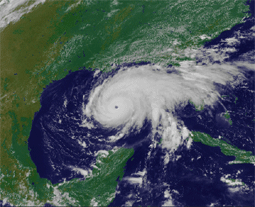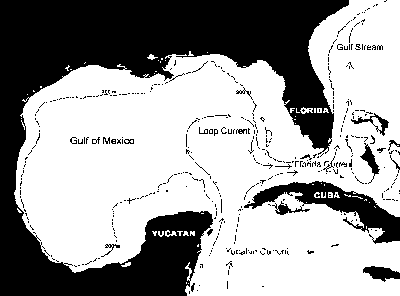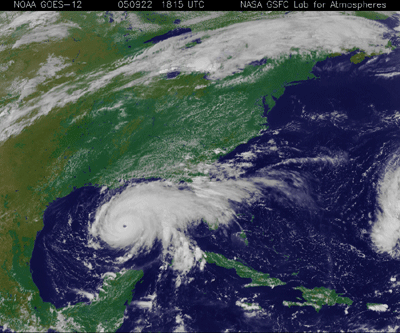
A NASA image shows Hurricane Rita passing over the loop current in the Gulf of Mexico. (Photo courtesy of NASA)
GELLERMAN: Nan Walker is director of the Earth Scan Laboratory at the Louisiana State University’s Coastal Studies Institute. Professor, again, thank you very much.
WALKER: You’re very welcome.
Related links:
- NOAA Satellite Map
- Professor Nan Walker bio Back to top
GELLERMAN: One third of the Netherlands is below sea level, and while the picture of the little boy in wooden shoes holding back the sea with his finger in the dike is an enduring, perhaps endearing, image of Holland, it’s far from accurate.
Following what‘s called “the Misery of 1953,” the worst flood in modern Dutch history, the Netherlands built an elaborate and formidable sea defense system. On the line from Delft is J.K Vrjiling, a flood risk analyst at the Technical University Campus in the 17th century city. Thank you for joining me.
VRJILING: Thank you.
GELLERMAN: Describe this, what’s called, I guess, the Delta Works. The system of dikes and gates.
VRJILING: Yeah, the Delta Works are, in principle, based on the shortening of the coastline. From the old days on there have been always estuaries going into country, and that meant along these estuaries long dikes had to be maintained. And the main principle was to shorten the coastline and close off these estuaries by new and formidably strong dikes.
GELLERMAN: As I understand it, these Delta Works were designed to be tough enough to stand up against a storm so strong it would occur only once in 10,000 years?
VRJILING: That’s correct.
GELLERMAN: How could that possibly be? How could you design something and know that it’s going to last for 10,000 years?
VRJILING: It doesn’t last for 10,000 years without maintenance. But it’s based on an extrapolated storm search. We have 100 years of statistics about storm surge levels on the Dutch coast, and this is extrapolated to a level of once in 10,000 years, and that’s our five meter storm surge level.
GELLERMAN: Five meters is as high as it would get, you predict, in 10,000 years?
VRJILING: Once in 10,000 years, yes.
GELLERMAN: And this system of dams and dikes could actually withstand that?
VRJILING: Yep, it should be able to withstand that.
GELLERMAN: Professor, I was reading about another expert in Rotterdam at Erasmus University, Anton Smitz , and he’s a biologist. And he says that there are reasons for concern caused by these dikes and dams.
VRJILING: Yeah, he’s not an engineer so he has doubts if it’s possible to increase the height of the dikes and the strength of the dikes. So his idea is that we, as Dutchmen, were not wise to inhabit this low laying lands and that we do better in leaving them over to the sea again and let nature have free reign in our areas. But we say that’s not so practical. We started to live here, we have a comfortable life here, and our technical means are sufficient to protect us against floods as long as we keep our own promises.
GELLERMAN: So Professor, you don’t sound very concerned. You sound like this system…
VRJILING: No, the only concern that we really have is that the politicians are able to take decisions, eh? That may be also the case in New Orleans – that if you find out that you have to do something, that you’re then able to do it.
GELLERMAN: I don’t understand.
VRJILING: Suppose we measure sea level rise, and how many years does it then take to get a political decision to increase the strength of the dikes?
GELLERMAN: I see. So you’re expecting that the sea will rise, perhaps at a greater rate than had been anticipated, and that the political decision-making process will be slower than that?
VRJILING: Exactly. That could be the case. And that’s the main danger in my eyes.
GELLERMAN: Well, Professor, thank you very much. I appreciate it.
VRJILING: Okay, thank you very much.
Back to top
GELLERMAN: President Bush has promised to provide the funds to restore New Orleans. But what should the new New Orleans look like? A newer version of the old one? Or a city that boldly ventures into the forefront of the 21st century?
In the coming months there will no doubt be many proposals, controversial and competing. One of the first comes from Bruce Babbitt, the Secretary of the Interior in the Clinton administration. He offers a back to the future proposal of what New Orleans can be, combining the classical and the contemporary, with a look to the future.
BABBITT: Most of southern Louisiana is going to be underwater in the coming century as sea levels continue to rise another foot, two, maybe three feet. And so, as we begin to think about rebuilding New Orleans we gotta look around and say “how we’re going to do it?” And my conclusions was that we’re going to have to envision New Orleans as an island.
GELLERMAN: You actually mean to create an island out of the city? Would it be built up? Would there be a dike around it? A moat? How would that work?
BABBITT: Well, my vision of an American Venice, if you will, is you would begin with the existing levee system. You would simply recognize, though, that with the sinking of the Delta, which, of course, we’ve all come to understand is because we’ve mismanaged the Mississippi River. And the sediment that used to build the Delta and keep it above sea level is now being trapped in all those dams a thousand miles away up on the Missouri River. The rest of it, because of the levee system, is going out to deep water.
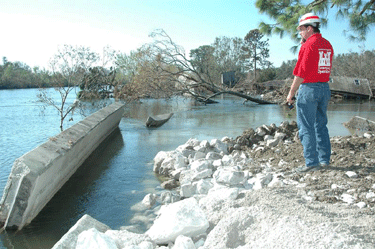
A member of the U.S. Army Corps of Engineers examines a breach in a floodwall on the London Canal, New Orleans. (Photo courtesy of U.S. Army Corps.)
So, the Delta continues to sink, sea level continues to rise, and the levee system will simply have to be raised and strengthened. But not just up against Lake Pontchartrain and not just in bits and pieces, because the sinking Delta will bring the water all the way around. So it will take a large levee system, connected by a causeway that will go across open water for twenty, thirty, forty miles. Something like the Interstate across Lake Pontchartrain. But it will effectively be the principle and only access route into a city surrounded by water.
GELLERMAN: Well, are those questions being asked now? Has your idea gotten any traction?
BABBITT: Well I can’t say there’s been a, you know, stampede toward lining up at my door listening for advice. But the comparison that I’ve tried to lay out is what happened in Florida historically. In 1947 there were two huge hurricanes that put 90 percent of South Florida under water. Absolutely devastating. And out of that experience the Florida legislature invented some new institutions. They created an entity called South Florida Water Management District, gave it the powers to plan water management across the entire landscape of South Florida. And they’ve flood-proofed South Florida; there has never been a flood disaster since then. There’s been a lot of hurricanes and, mind you, plenty of damage localized from hurricanes. But the sort of Biblical floods that used to plague South Florida have been eliminated through broad, landscape-scale planning for the management of land and water. That’s what’s missing in South Louisiana right now.
GELLERMAN: Any guesstimate on the cost associated with turning New Orleans essentially into an island?
BABBITT: Well, it won’t be really any more costly than what they’re already talking about to rebuild it. And all I’m saying is we must, before we spend that money to replicate what was there two months ago, we better think about what the landscape and the waterscape is going to look like in 50 years. And then, rebuild the infrastructure of the island, including the internal circulation, the streets, water, sewer, infrastructure and the levy itself and the connection to the levees along the Mississippi River so that the city, if you will, is kind of, think of it as an American Venice. So there’s not vulnerable, ‘cause if it’s done in the same fashion as the past it’ll just be vulnerable from a different direction next time.
GELLERMAN: You know, when you say American Venice, I really like that idea. I must tell you I can just hear the Zydeco music on gondolas. It’s a great idea.
BABBITT: Well, I think jazz is a much richer tradition than those guys playing guitars on gondolas, actually.
GELLERMAN: (Laughs). Secretary Babbitt, thank you very much. It was a real pleasure, sir.
BABBITT: It’s been a pleasure. I enjoyed talking to you.
GELLERMAN: Bruce Babbitt was the Secretary of the Interior in the Clinton administration. His new book is called “Cities in the Wilderness.”
Back to top
[MUSIC: Mojave3 “Tomorrow’s Taken” from ‘Ask Me Tomorrow’ (4AD - 1996)]
GELLERMAN: Coming up: One small step, and then? Whatever happened to the men who walked the moon? Find out when we return with Living on Earth.
[MUSIC: Bionaut “Bluebelle (The Birth of a Bionaut)” from ‘Lubricate Your Living Room’ (Matador - 2001)]
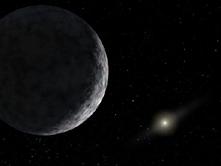
This artist's image shows the object catalogued as 2003UB313 at the lonely outer fringes of our solar system. Our Sun can be seen in the distance. The "planet" was discovered by the Samuel Oschin Telescope at the Palomar Observatory near San Diego, Calif., on Jan. 8, 2005. (NASA/JPL-Caltech)
GELLERMAN: It’s Living on Earth, I’m Bruce Gellerman, sitting in for Steve Curwood. Astronomers have some good news, and possibly some bad news. The good news? They might have discovered a new planet. The bad news? We might need it.
Joining us is astrophysicist Neil deGrasse Tyson, head of the Hayden Planetarium in New York City and a frequent contributor to our program. Welcome back to Living on Earth, Dr. Tyson.
TYSON: Great to be back with you.
GELLERMAN: So, how exciting, they might have discovered a new planet in our solar system? The first since Pluto in 1930?
TYSON: Well, we’ve been discovering things in the outer solar system for quite some time now, or at least since the early 1990s, and so every time a new one of these objects is discovered, the media sort of jumps on it and says, “oh, another planet! Another planet!”
And then we look and see, well, it’s kind of small, and mostly ice, and should it be a planet? And then that brings up the concern about what the definition of a planet is, and is Pluto really a planet? And so it goes on and on and on and on and on.
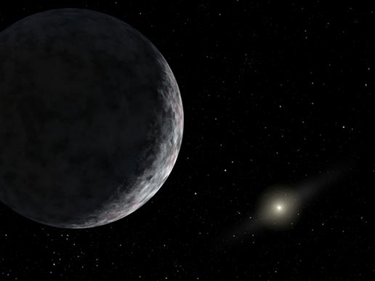
This artist's image shows the object catalogued as 2003UB313 at the lonely outer fringes of our solar system. Our Sun can be seen in the distance. The “planet” was discovered by the Samuel Oschin Telescope at the Palomar Observatory near San Diego, Calif., on Jan. 8, 2005. (NASA/JPL-Caltech)
What makes this recent discovery rise above the rest is that this object is bigger than Pluto. So, whatever rules you invoke for Pluto, they would surely then have to apply to this object. So that’s what made it exciting.
GELLERMAN: So, do you think it really is a planet?
TYSON: Well, as you may know, in the Rose Center for Earth and Space here in New York which contains the rebuilt Hayden Planetarium, we opened in 2000, and our exhibits did not count Pluto among the rest of the planets in the solar system. Rather than count planets, which I personally think is a pointless exercise – there’s no science in how many planets there are orbiting a sun – what you want to do is group them by like properties. Then there’s some knowledge to be gleaned from that. You can even teach that in elementary school.
So, rather than count and enumerate the planets, we grouped, for example, the small rocky objects in the inner solar system – Mercury, Venus, Earth, Mars – we grouped them together. And those are the terrestrial planets. The word is still a convenience, but you know they’re all small, rocky and dense. Then there’s the big, giant, gaseous, low-density Jupiter, Saturn, Uranus and Neptune. They fit together as a family. There’s the asteroid belt that separates the two.
And in each of these families, the objects within them look more like each other than any one of them look like the other families. So now you have Pluto, which doesn’t match anything else in the solar system except for other objects we’ve recently discovered orbiting the sun with it. These are objects that are mostly ice by volume which, if they came close enough to the sun, they’d grow a tail. Well, we have words for icy objects that grow tails: they’re comets. And so we have relegated Pluto and its icy brethren to this new swath of real estate, recently discovered, which is the swarm of comets orbiting beyond Neptune.
GELLERMAN: Well, what does this object look like?
TYSON: Well, it’s not clear, orbiting very far away but still within the zone that we’ve identified as the zone of comets. By the way, there was an astronomer at mid-last century who theorized there might be this reservoir of comets beyond Neptune, and his name was Gerard Kuiper, so we call it the Kuiper Belt of Comets.
So, Pluto and this new object each orbit within the Kuiper Belt of Comets. We know that it is at least bigger than Pluto; could be much, much bigger than Pluto, it’s not yet known. Its surface is surely almost 100 percent ice, and the rest of its volume is likely to be like the rest of what you find in the Kuiper Belt: mostly ice.
GELLERMAN: Now, this thing has got the unmemorable name of 2003UB313, am I right?
TYSON: Yeah, that’s its phone number, we like to call it (laughs).
GELLERMAN: Not a very catchy name though.
TYSON: Yeah, and we don’t use – I mean, that’s the catalogue name, but even between friends and astronomers, we’re ready to get the thing named according to the way other objects in the solar system are named, and we will surely use that new name thenceforth. But that takes a little while. We have to entertain suggestions. The discoverer wanted to name it “Xena,” the famous warrior princess of television fame.
GELLERMAN: Huh.
TYSON: I kind of like that name. It has that kind of Greek sound to it, even though it’s just a made-up name. It’s not likely that will get through the judges, but we’ll see.
GELLERMAN: Well, if there is a new planet, Dr. Tyson, it might come in very handy in the near future. I hear that astronomers have identified an asteroid that’s heading our way?
TYSON: Yes, an asteroid was discovered mid-last year, and it has the uninteresting name 2004MN4. And it went unremarked upon on because many asteroids are discovered each year that never reach public notice. Except that when it went behind the sun, going out of view from the sun’s glare, and then was rediscovered in December, we were able to calculate its orbit and determine that it’s trajectory was going to intersect Earth in the year 2029 or the year 2036. This didn’t make it to the front of the newspaper because around that same time, you might remember, there was a tsunami in Indonesia – which, of course, rightly so, got the better part of all the headlines. But, ironically, this object, if it hits Earth, would create a tsunami dwarfing the one reported on in December ’04.
GELLERMAN: What are the chances of this asteroid hitting Earth?
TYSON: Well, rather than give you probabilities, because what you really need to know is what’s going on. We know where the object is headed, and we know how fast it’s moving, and we have a sense of the forces of gravity in the solar system. The problem is the uncertainty in that trajectory normally is not a problem; if it misses Earth by a million miles, or a million and a thousand miles, who cares? But, in this case, in the year 2029, the calculations show that this asteroid will come within the orbits of even our communication satellites.
GELLERMAN: Ooh, that’s close.
TYSON: That’s close. That’s close. This will be the largest object ever known to come within our communication satellites in the era of space exploration. And so, turns out, what we know of the orbit right now, we can say it will not hit Earth in 2029 but it might hit Earth in 2036. It will hit Earth in 2036 if it passes through what we call a “keyhole,” which is a range of positions close to Earth where the gravity of the Earth will realign its trajectory ensuring that seven years later it will hit Earth. And so what we need to do is deflect it in such a way that it misses that keyhole.
GELLERMAN: So, this keyhole’s kind of like a place in space, a doorway?
TYSON: Exactly! It’s like a car door through space where the gravity of Earth operating on that asteroid in that corridor will pull on that asteroid in 2029 in such a way that in 2036 it will hit Earth. So, you want to deflect the asteroid so that it misses that keyhole.
GELLERMAN: So, if it did hit Earth, do we know where it might hit?
TYSON: If the asteroid in 2029 passes anywhere in the keyhole we know where it will end up hitting Earth in 2036. It’ll hit somewhere between Hawaii and California in, obviously, the Pacific Ocean. That hit will generate tsunamis on the level that has never been experienced in recorded history. But the advantage is you would know in advance so that, while you might lose $400 billion worth of property, no one actually has to die from this tragedy the way people died in Indonesia. There was no warning for that tsunami. This one you can have decades of warning if, in fact, we can’t do anything about it.
GELLERMAN: So, it sounds like we should be planning for this right now.
TYSON: Right now, there’s legislation in front of Congress to try to vote sensibly about directing monies for study. What would be the best way to deflect it? Do you shoot laser beams at it? Do you attach retrorockets to it? There’s some leading ideas but there are many other ideas in the bin that are being considered. So, Congress has taken the first step.
GELLERMAN: So, Dr. Tyson, do you stay awake at night worrying about the demise of Earth from asteroids?
TYSON: Yeah, well, this asteroid is deflectable. It’s about, you know, 200 meters across, about the size of the Rose Bowl, and, so this one, yeah, I know they’re out there, and it’s a shooting gallery. The ones I really worry about, however, are the kind that’s the size that took out the dinosaurs. Those things are the size of Mt. Everest. That can happen again. It will happen again. And, in that case, if anyone survived you’d have to jumpstart civilization. That’s what I worry about. This is one of the calls for being a multi-planet species – one planet gets taken out, you at least have another one left. Or find really effective ways of deflecting these things.
GELLERMAN: You’re making planet Xena sound better and better all the time.
TYSON: (Laughs) Yeah. Planet Xena will be cold and dark, but Mars looks pretty good, actually.
GELLERMAN: Dr. Neil deGrasse Tyson is director of the Hayden Planetarium and co-author, with Donald Goldsmith, of the book “Origins: Fourteen Billion Years of Cosmic Evolution.” Dr. Tyson, it’s always good talking with you. Thank you.
TYSON: Thanks for having me on.
Related links:
- A Paper on the Asteroid by Russell Schweickart, B612 Foundation: "A Call to (Considered) Action"
- Neil deGrasse Tyson's biography
- "Origins: Fourteen Billion Years of Cosmic Evolution" by Neil deGrasse Tyson and Donald Goldsmith Back to top
[MUSIC: Clogs “Pencil Stick” from ‘Stick Music’ (Brassland – 2005)]
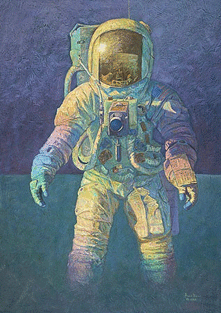
"That's What It Felt Like to Walk on the Moon" (Alan Bean, © The Greenwich Workshop, Inc.)
GELLERMAN: Sending a man to the moon is a trophy that America has proudly displayed on the nation’s mantle since 1969 when Neil Armstrong took one small step and became the first man to walk on the moon. That trophy has gathered more than a little dust since the age of the Apollo Project, no one’s been back to the moon in over 33 years.
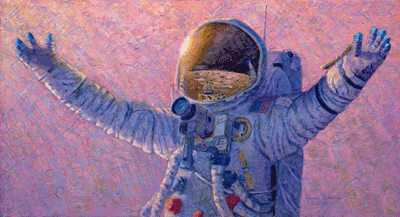
“Hello Universe" (Alan Bean, © The Greenwich Workshop, Inc.)
But now, NASA plans to jump-start its lunar project, and promises to send a man back to the moon by 2018. Only a dozen men have been to the moon, and of those twelve, only nine survive. Writer Andrew Smith wondered what became of those men who shared that extraordinary experience. His new book is called “Moondust: In Search of the Men Who Fell to Earth.” He joins me now. Andrew, hello.
SMITH: Hi, nice to be here.
GELLERMAN: I want you to clear up something for me right away. Listen to the quote by Armstrong and you tell me what he’s saying.
RECORDING OF ARMSTRONG: That’s one small step for man, one giant leap for mankind.
GELLERMAN: It’s a little garbled there, but does he say “one small step for man” or “a man”?
SMITH: Well, to me it sounds like “man”, but he insisted for years that he said “a man.” But I think it’s fairly clear from that that he left out the “a.”
GELLERMAN: Did he come up with that himself? In the book you suggest it might not have been the case.
SMITH: Well, one thing we do know, I think, is that NASA didn’t tell him what to say. Because the commander of the second mission, Apollo 12, which landed later in that year, 1969, he had an Italian journalist friend who just didn’t believe that Neil Armstrong had been allowed to make up the words himself. So Pete Conrad, who was a very colorful character, this commander, he bet her 500 dollars that he could nominate the words he was going to say there and then, which he did. And he was a diminutive guy, Pete Conrad, so, sure enough, when he stepped off the ladder all the viewers and listeners heard him say, “Whoopie, that may have been a small step for Neil, but it was a big one for me!”
GELLERMAN: (Laughs)
SMITH: So I think, yeah, I think Armstrong probably did make it up.
GELLERMAN: You spoke to all of the nine surviving moonlanders.
SMITH: I spoke to all of them. Seven of them sat down for proper interviews and sort of lengthy chats, yeah.
GELLERMAN: They were all very strange men, the way I read your book.
SMITH: Yes, and I was going to say, one of the big surprises for me was what a diverse group of individuals they are. Because I’d expected that they would be fairly buttoned down, straight arrow sort of guys, and, in actual fact, they ranged right across the spectrum.
For instance, Edgar Mitchell, who was on the third mission to land, had what he called an epiphany on the way back from the moon and felt as though there was a consciousness around him in the universe. And he felt plugged into it and came back and quit NASA and founded a New Age organization.
Another quit NASA, Alan Bean, quit NASA and became a painter afterwards. And he now endlessly paints scenes from the moon landings in oils, and he’s very, very successful at it. Another one felt he heard God talking to him on the surface of the moon. He came and quit when he got back and founded a ministry. So they really are a diverse bunch of people.
GELLERMAN: You don’t paint a very good picture of Buzz Aldrin, actually. He’s very competitive, and you say that when he was on the moon he only takes one picture of Armstrong, and that’s a picture of him being reflected in Armstrong’s visor.
SMITH: Yes, that’s right. Michael Collins, who flew with him, who was the command module pilot, which means he was the one who stayed in the command module circling the moon and didn’t land, he has said that Buzz took more umbrage with not being the first on the moon than he got joy from being the second. And he suffered a lot when he got back. He suffered from depression and alcoholism which wasn’t spotted for a long time.
And don’t forget that these guys weren’t well paid. Those who were military were paid according to their military rank. At that time, that wasn’t a great deal of money. And there was no danger money or anything like that. So I think Buzz, he’s had a hard time. I mean, I can empathize with him a great deal, I think.
GELLERMAN: Yeah, there’s a real sadness in the book. You write about one of the astronauts selling his autograph in Las Vegas for 10 dollars a pop.
SMITH: Well, yeah, his name was Dick Gordon. He was the command module pilot on Apollo 12, the second mission. And the funny thing is that, as far as all the memorabilia goes and the Apollo nuts and the celebrity aspect of the whole thing, as one collector explained to me, the command module pilots market value is much lower than any of the others. So they can’t sell their autographs at 500 dollars a time the way Buzz does.
So I actually found him, yeah, at a Star Trek convention in Las Vegas, sitting at a table on his own signing autographs for 20 dollars a time, surrounded by all these other actors. And there were big lines at the other tables, people waiting to have their autographs signed, and then here was this genuine space hero who didn’t have a big line. It was a strange and strangely poignant place to find someone who had been all the way to the moon.
GELLERMAN: The trip Apollo was about us.
SMITH: Yeah, I think it was, you know. I really think it was. And one of the things you notice when you go and meet these people who’ve had this extraordinary experience, and they are extraordinary men in lots of ways, but in other ways they’re very, very ordinary people just like you and me. And they’re having to deal with our expectations and our hopes of them. For instance, when people meet them they invariably ask, “so what was it like up there?” And there really is no simple way of answering it. It’s what they all say. And it’s one of the things that’s frustrated every single one of them.
So I think it really was about us, yeah. And the fact that they were going in the first place was about us because there was no rational. There was no reason for them going in terms of science, geology, technology. All the scientists said that robots could do it just as well at a fraction of the cost and it would be much safer. But there was something about a human being going up there and actually being there and coming back and telling us about it, which we really wanted. And John F. Kennedy had no interest in space when he announced this, but he knew somehow that it was in the imagination, it would capture the imagination, and that people would respond to it. And, of course, they did.
GELLERMAN: Andrew Smith is author of “Moondust: In Search of the Men Who Fell to Earth.” Mr. Smith, thank you very much.
SMITH: It’s a pleasure.
GELLERMAN: Alan Bean was the fourth man to walk on the moon as the lunar module pilot for Apollo 12. He left NASA in 1981 and set up an artist’s studio at his home in Houston, Texas, where he paints. Many of his paintings of the moon will soon be exhibited at the Butler Museum of American Art in Youngstown, Ohio. And Captain Bean, thank you very much for joining us.
BEAN: Well it’s my pleasure, Bruce. And hello, listeners.
GELLERMAN: How did you go from astronaut to artist? How did that happen?
BEAN: Well, I think we’re all trapped, all humans are trapped, being just who they are, and that was an interest that I had even before I became an astronaut. When I was a test pilot in the Navy I began to take watercolor, drawing, and things like that at night in a university near us. So when I got back from the moon and realized that hey, you know, I’ve been to a place that no artist has ever been in all of history, another world, maybe if I could learn to paint it well enough I could do something worthwhile. And, you know, celebrate what we as Americans did.
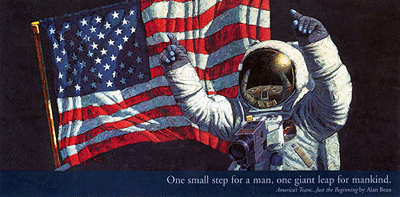
"America's Team...Just the Beginning" (Alan Bean, © The Greenwich Workshop, Inc.)
GELLERMAN: I once heard that in addition to your brushes you actually use moon tools for your paintings?
BEAN: Well, yes. I’ve always liked texture in a painting, and I wanted some moon dust, but we didn’t get any. Nobody has a rock from the moon that I know of. I certainly don’t. So I couldn’t put any moon dust in my paintings. And one day I was looking up on the wall, they did give me the patches from my suit, the flag, you know, on my shoulder, the Apollo 12 patch on my chest –
GELLERMAN: Uh-huh.
BEAN: So I said, you know, they sure are dirty, and then it dawned on me: they’re dirty with moon dust. If I cut those things up –
GELLERMAN: You didn’t!
BEAN: – and put them in my painting I really would have moon dust in my painting.
GELLERMAN: You did it?
BEAN: I did it, yeah. I didn’t want to, ‘cause those meant a lot to me. I said, well, I’m spending the rest of my life doing these paintings, so if I’m using my life up I certainly can use up my patches.
GELLERMAN: Captain Bean, do you have a favorite picture that’s going to be showing at the Butler Museum of American Art?
BEAN: One of my favorites. Pete Conrad, the commander of our mission, one of my very best friends ever, he was killed on a motorcycle some five, six years ago, and so there was one with the three of us in it – Pete Conrad, Dick Gordon, Al Bean – on the moon. Now, Dick Gordon never got on the moon, he stayed in the command module, but as an artist I had him on the moon standing between us, and I call the painting “The Fantasy.” There the three of us that worked together, cared about each other, and tried to make, you know, this American dream come true.
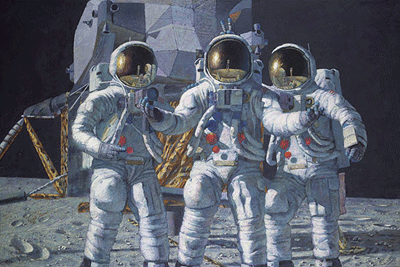
"The Fantasy" (Alan Bean, © The Greenwich Workshop, Inc.)
GELLERMAN: Captain Alan Bean’s paintings will be on display at the Butler Museum of American Art in Youngstown, Ohio. Captain Bean, thank you so very much.
BEAN: Bye-bye, Bruce.
Related link:
"Moondust: In Search of the Men Who Fell to Earth" Back to top
[MUSIC: Samuel J. Hoffman “Music For Peace Of Mind” from ‘Theremin: Music Out Of The Moon’ (Basta - 1999)]
GELLERMAN: Just ahead: think globally, but eat locally - Bill McKibben's homegrown winter diet is next on Living on Earth.
ANNOUNCER: Support for NPR comes from NPR stations, and: The Charles Stewart Mott Foundation, online at m-o-t-t dot org, supporting efforts to promote a just, equitable and sustainable society; The Kresge Foundation. Building the capacity of nonprofit organizations through challenge grants since 1924. On the web at k-r-e-s-g-e dot org; The Annenberg Fund for excellence in communications and education; and, The W-K Kellogg Foundation. ‘From Vision to Innovative Impact: 75 Years of Philanthropy; This is NPR, National Public Radio.
[MUSIC: Medeski, Martin & Wood “New Planet” from ‘End of the World Party (Just In Case)’ (BlueNote - 2004)]
GELLERMAN: It's Living on Earth. I'm Bruce Gellerman, and coming up: the tomato that bought a house? First, this Note on Emerging Science from Emily Torgrimson.
[SCIENCE NOTE THEME]
TORGRIMSON: A day in the life of a guppy: cruise ‘round the plastic castle, swim up to the surface for pellets, check out the bejeweled mermaid on the far side of the tank, and now, help fight a dengue epidemic in India.
In recent weeks, dengue fever has killed dozens of people and affected hundreds in West Bengal, India. Dengue is a mosquito-born disease that causes fever, nausea, headaches, and, if it is not treated, death. But health officials in West Bengal have released thousands of guppies into waters where mosquitoes breed.
Mosquitoes there are proving resistant to many pesticides, so officials are relying on the help of guppies and gambusia - a fish commonly known as “the mosquitofish” because of its ability to eat its weight in mosquito larvae a day. And both fish species can survive where water quality is poor, like stagnant ponds or shallow bodies of water.
Critics of the method say guppies and gambusia often grow to outnumber native species of fish – they attack other fish by nipping at their fins, eyes, and preying on their eggs. There’s no indication yet of the immediate effect the fish are having on the dengue epidemic, or other mosquito-born illnesses, like encephalitis and malaria.
That's this week's Note on Emerging Science. I'm Emily Torgrimson.
Back to top
GELLERMAN: This is apple harvest time here in New England and fresh picked local varieties can now be found at roadside stands and farmers' markets. This is a season New Englanders cherish, and it couldn't have come too soon for Bill McKibben.
McKIBBEN: The apples in my market annoy me. They’re from China and New Zealand and Washington state, and I live in Vermont’s Champlain Valley, one of the world’s great apple-growing regions. So, what an annoying waste of energy to fly these Red Delicious in from halfway around the planet. And what a waste of taste—these things have been bred for just one purpose-- endurance. Mostly, though, they’re annoying because they don’t come with connections, with stories. They’ve been grown on ten thousand-acre plantations with the latest industrial methods and the highest possible efficiency. They’re cheap, I give you that. But they’re so dull.
[HUMMING SOUND OF CIDER PRESS]
McKIBBEN: The roar you hear is a cider press. It belongs to my neighbor, Bill Suhr. His fifty-acre orchard produced a million pounds of apples last year, so he’s not a backyard hobbyist.
SUHR: This time of year we’re putting six varieties in: the Macintosh, Empire, Cortland, Macoun, Northern Spy, and Jonagold.
McKIBBEN: I drank a lot of Bill Suhr’s cider this past winter because I’d asked the editors at Gourmet magazine if I could perform an experiment: could I make it through the winter feeding myself entirely on the food of this northern New England valley where I live. Up until 75 years ago or so, everyone who lived here obviously ate close to home—an orange or a banana was a Christmas-time treat.
And that’s still how most people on the planet eat. But I knew that most of the infrastructure that once made that possible was now missing. Our food system operates on the principle that it’s always summer somewhere, so it’s forgotten how to get through winter. How many houses have a root cellar? Not mine. If I was going to make it, I would need to make connections with my neighbors. Ben Gleason, for instance.
GLEASON: Well, let’s see, last year I went through I believe, 32 tons of wheat. Spring and summer were just wonderful and I thought, “Oh my gosh, we’re going to have a normal year in Vermont,” but then it started raining and it just go so wet that I had problems in harvesting. Almost everybody did.
McKIBBEN: Ben Gleason grows wheat on his farm in the nearby town of Bridport, Vermont. I’d always imagined wheat just came from the Midwest, and indeed, that’s where it can be grown most cheaply. But Ben’s been growing it for a quarter century here, hard red winter wheat which he grinds himself in a little shed next to his barn and then sells at the local co-op for 59 cents a pound, not much more than the stuff from the giant mills.
[SCOOP DIGGING IN THE WHEAT BIN]
GLEASON: This is the bread flour.
McKIBBEN: Ecologically it makes a lot of sense: instead of traveling 1,500 miles like the average bite of American food, it only needed to cover ten miles before it reached my kitchen. And since it’s easily available, it’s starting to help other local businesses turn more local. The local pizzeria makes its dough with it, and the local bagel shop. And some of it—some of it goes to our local brewery, Otter Creek, owned by Morgan Wolaver
WOLAVER: I would love nothing more than to be able to survive financially in producing beer for the state of Vermont. Local beers are more fresh.
McKIBBEN: By Christmas-time, I’d settled into my routine. Local oats for breakfast, or pancakes. Maple syrup is the quintessential Vermont crop. Cheese sandwich for lunch—the local cheese factory is right next to the brewery. And for dinner, some potatoes, some carrots, some squash, some beets, and some creature—something that had been baa-ing or moo-ing or snorting a few weeks before, busy converting the grass of this valley into protein.
[HOGS SNORTING]
McKIBBEN: Some of my favorite protein came from Essex Farm, on the New York side of Lake Champlain. Mark Gunther and his wife, Kristin Kimball, opened this enterprise two years ago. You sign up to be a member and then you appear every Friday afternoon and Mark loads up your car with food.
GUNTHER: We have carrots, cabbage, beets, celery root, turnips, leeks, onions, pumpkins, butternut and buttercup squash, parsley, and kale all harvested fresh today. I think that’s about the vegetable department.
McKIBBEN: But the vegetable department is only the beginning. They’ve got a small beef herd, so there are always steaks and hamburger in the freezer. The pigs produce bacon and ham. The chickens and the turkeys taste good, too.
[SOUND OF CHICKENS]
McKIBBEN: They raise bees, they grow their own wheat. Except for dental floss, you’d never need to set foot in a store again.
[SIZZLING PAN]
McKIBBEN: Today, Mark is making cheeseburgers for lunch.
GUNTHER: This is beef from the bull that we ate for our wedding, and this is hamburger from him. We called him Charlie. So it’s Charlie, with a little bit of Rea and Delia and Melissa in the cheese.
McKIBBEN: Mark Gunther is even more interested in local than I am. And yet there’s nothing particularly grim or Luddite about his life. Just the opposite.
GUNTHER: There’s nothing inherent about modern ways that I don’t support. I’m trying to find out ways to increase the quality of my life, and I think, by extension, the lives of those around me.
McKIBBEN: In fact, Mark is at least as much an innovator as a throwback. When his wife, Kristin, got tired of churning butter by hand every week, he came up with a solution:
[LATINO RHYTHMS]
GUNTHER: I realized that someone had given us a fold-out bed, and that, probably, if I opened that up and put the milk can on it and bounced it, that I could be able to make butter quickly. And so now my weekly ritual has been every Tuesday or Wednesday night to turn on some Latino rhythms that I feel like listening to and I kind of do a kind of modified jumping dance with my fifty pounds of stainless steel and cream. Usually within about 600-700 bounces I open it up and find 10-12 pounds of butter ready to be rinsed and worked.
[LATINO RHYTHMS]
McKIBBEN: And his butter tastes great, too; maybe even better because I know its story. I’m not going to claim that every day of this experiment was pure gustatory bliss. There were moments when I sympathized with my daughter, Sophie.
McKIBBEN: Can you tell the difference between a parsnip and a turnip?
SOPHIE: No, I don’t want to. They’re disgusting.
McKIBBEN: When spring came, I was happy to eat the odd banana and drink the occasional pint of Guinness Stout. But I don’t think I’m ever going back to eating the way I used to. I could give you a lot of good reasons—there’s a British study, for instance, that just came out proving that eating local helped the environment twice as much even as eating organic. But all that’s just an excuse. I’m hooked on the connections to the place I live. I spent the winter eating with my mind as well as my tongue, consuming connections along with my calories. It was the best dining I've ever done. I'm not going back to orange juice. I'm sticking with cider.
GELLERMAN: Bill McKibben is the author of "Wandering Home: A Long Walk Across America’s Most Hopeful Landscape, Vermont’s Champlain Valley and New York’s Adirondacks." His story on local food was produced by Jay Allison, Chelsea Merz, and Viki Merrick. Special thanks to the public radio website, Transom-Dot-Org, and the Corporation for Public Broadcasting.
Back to top
[MUSIC: John Fahey “Poor Boy Long Ways From Home” from ‘Best Of John Fahey: 1959-1977’ (Takoma - 2002)]
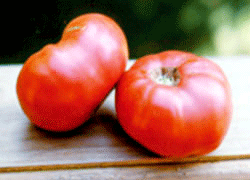
Photo courtesy of Jeff McCormack
GELLERMAN: These days at harvest festivals and county fairs you can find green thumb growers showing off the fruits of their labors--local produce grown with care and pride…and can anything be more worthy of a boast than a delectable tomato, ripening on the vine right in your own backyard? Especially those heirloom varieties, the ones with odd shapes, colors and names to match. There are the Tommy Toes, tiny as grapes, Brandywines, deep red as a glass of cabernet, and Banana Legs, yellow and yummy. Living on Earth’s Jeff Young was curious about one of his favorites, a tomato with an especially peculiar name, and he discovered a story behind it as colorful as the fruit itself.
YOUNG: Where I grew up in West Virginia, old timers called them “Mortgage Lifters.” They’re tasty without being acidic, and the flattened, pinkish fruits get big. Really big—I’m talkin’ a pound or two apiece. The best of them carried a longer name: “Radiator Charlie’s Mortgage Lifter Tomato.” I often wondered about that name. So did Jeff McCormack.
YOUNG: Mccormack runs a seed catalog company from his home in Charlottesvile, Virginia. He specializes in rare lines of heirloom plants and seeds passed down through families and friends.
MCCORMACK: But, you know, when it’s being passed down in a family for 200 years there must be something good about it.
YOUNG: In the mid 80s, McCormack got his hands on some tomato seeds and a heck of a story. It came in the form of a scratchy old tape recording of a conversation between Ed Martin of Virginia, and his grandfather, the originator of the Mortgage Lifter Tomato.
MARTIN: I am sitting at 860 Lee St talking to my grandfather MC Byles and he’d get mad if anybody said it is Marshall Cletis Byles.
YOUNG: Marshall Cletis Byles preferred to go by MC or just Charlie. The tape is tough to hear—cars, trains and, at one point, an ice cream truck interfere. But it rewards the careful listener. Martin tries to keep his grandad on topic—he wants to know the origin of the Mortgage Lifter Tomato.
MARTIN: That’s a heck of a tomato. Look, didn’t you tell me there were five tomatoes that made that thing?
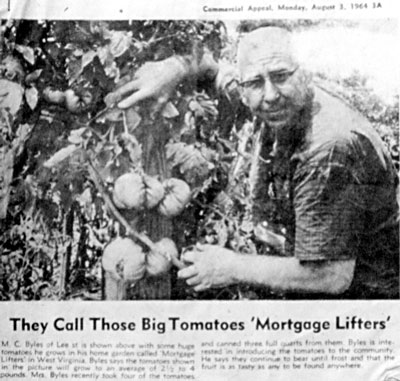
M.C. "Radiator Charlie" Byles shows off the fruits of his labor, the Mortgage Lifter tomato, for a Virginia newspaper in the mid-1960s. (Photo courtesy of Jeff McCormack)
YOUNG: Byles talks about the tomato all right, but not right away. He wanders in his recollection, as 85-year-olds are wont to do. He talks about cars he’s owned, jobs he’s worked, places he’s lived—and what emerges is the story of a truly remarkable life. The grandson asks how Charlie got started with gardening. Byles tells him it was when his mother sent him to work in the cotton fields of North Carolina. He was four years old.
BYLES: Mother said “come out from under there.” I said “what do you want?” She said, “you’re going to work.” “I’m too little to work.” “No, you are not.” I had to go out there and start pickin’ cotton.
YOUNG: As a young man in the National Guard, Byles took up wrestling and got so good he went on a wrestling tour of towns in Appalachia where it’s called “wrasslin.’ The pay was a dollar for every minute he lasted in the ring.
BYLES: What you did, if he didn’t throw you in 10 minutes, you’d get a dollar a minute. I never lost, but very few times.
YOUNG: Byles learned to pilot small planes and flew airmail routes. He loved fixing planes and inventing things. He once came up with a new kind of garden tiller, but didn’t think to get a patent. He found business success as an auto mechanic in the rugged hills of Logan, West Virginia, where heavy coal and timber trucks constantly blew out radiators grinding up the steep grades.
McCORMACK: And I think that’s where he acquired his name “Radiator Charlie.”
YOUNG: That’s seed saver Jeff McCormack.
McCORMACK: Incidentally, the shop was located at the foot of a large mountain where the trucks had to roll back down the mountain to his shop after the radiator blew.
YOUNG: Location, location, location. He sounds like the classic American tinkerer.
McCORMACK: Exactly. And the beauty of it is that he did this all without formal education.
BYLES: Well, I’ve always had a mind of doing things that nobody else couldn’t do. I never been to school a day in my life but anything I wanted to do, I done it.
YOUNG: Sometime in the early 40s, Radiator Charlie Byles wanted to build a better tomato. You remember this is a story about a tomato, right? Well, this is how he did it.
BYLES: What I did I took ten plants and put them in a circle and put one in the center.
YOUNG: McCormack has studied this part of the tape carefully and says Byles invented an unorthodox but elegant system.
McCORMACK: Well, he started with four varieties of tomatoes and he placed a tomato called German Johnson in the center of a ring of 10 tomatoes. All these tomatoes were the largest seeds he could find in the country at the time. So, he would go around to the other tomatoes, collect pollen in the baby’s ear syringe, then squirt it on the flowers of the German Johnson. Then he would save seed. After seven years, he felt he had a stable tomato with all qualities he was looking for, and once he was satisfied with that he never worked with any other tomato plants, did any other plant breeding. But he really ran with it after he developed it.
YOUNG: Ran all the way to the bank. Turns out Radiator Charlie Byles had quite a knack for marketing, and sold tomato seedlings for a buck apiece—a lot of money for a little plant in those days. He sold enough of them to pay off the mortgage on his house.
BYLES: I didn’t pay but six thousand dollars for my home, and paid most of it off with tomato plants.
YOUNG: So, there you have it: Radiator Charlie’s Mortgage Lifter Tomato. McCormack says the story is more than just a good yarn. When he put it in the seed catalog it attracted curious gardeners who grew the tomato, saved the seed, and, perhaps unwittingly, helped keep the strain alive – a small victory for preserving genetic diversity at a time when most agriculture is heading toward a homogenized industrial scale. And McCormack finds something else of value in these seed stories, something a little harder to pin down.
MCCORMACK: What I’m trying to do is also sort of save the soul behind these seeds, the thin line that extends from one generation to another. And each, the people are connected with the seeds, culture and agriculture are inexorably intertwined. They’re like two sides of the same coin.
YOUNG: MC "Radiator Charlie" Byles died at the ripe old age of 97. At the time of his talk with his grandson, he had already outlived many of his friends and family. He wondered aloud why he had lived so long.
BYLES: The Lord left me here all these years for some purpose. I don’t know what it is.
MARTIN: Maybe it was that tomato. (LAUGHTER)
YOUNG: Maybe it was that tomato. And maybe that’s not so bad. For Living on Earth, I’m Jeff Young in Charlottesville, VA.
[MUSIC: Guy Clark “Home Grown Tomato” from ‘Keepers’ (Sugar Hill Records – 1997]
GELLERMAN: To see pictures of Radiator Charlie and his Mortgage Lifter Tomato and to learn more about heirloom seeds visit our web site Living on Earth dot org. That's Living on Earth dot o-r-g.
[MUSIC: Guy Clark “Home Grown Tomato” from ‘Keepers’ (Sugar Hill Records – 1997]
When I die don't bury me
In a box in a cold dark cemetery
Out in the garden would be much better
Where I could be pushin' up home grown tomatoes
Home grown tomatoes, home grown tomatoes
What'd life be without home grown tomatoes
There's only two things that money can't buy
That's true love and home grown tomatoes.
Related links:
- Seed Savers Exchange
- Southern Exposure Seed Exchange – Mortgage Lifter seeds page Back to top
GELLERMAN: Next week on Living on Earth – It’s been 16 years since two researchers ignited what’s called the greatest controversy in 20th century science. But today, long after cold fusion was considered dead and gone, some researchers say it's alive and has the potential to the produce unlimited and virtually pollution free energy.
NAGLE: People come to me and say, “Dave, it sounds too good to be true.” Well, yes, it is too good to be true, but that’s what the promise is.
GELLERMAN: The changing science of cold fusion - on the next Living on Earth.
[MUSIC UP AND UNDER]
GELLERMAN: Living on Earth is produced by the World Media Foundation. Our crew includes Chris Ballman, Eileen Bolinsky, Jennifer Chu, Ingrid Lobet and Susan Shepherd - with help from Christopher Bolick, Kelley Cronin and Michelle Kweder. Our interns are Ashley Ahearn, Brianna Asbury and Emily Torgrimson. Our technical director is Dennis Foley. Alison Dean composed our themes. You can find us at loe dot org. Steve Curwood returns next week. I'm Bruce Gellerman. Thanks for listening.
ANNOUNCER: Funding for Living on Earth comes from the National Science Foundation, supporting coverage of emerging science; and Stonyfield Farm, organic yogurt, smoothies and milk. Ten percent of profits are donated to efforts that help protect and restore the earth. Details at Stonyfield dot com. Support also comes from NPR member stations, and the Ford Foundation, for reporting on U.S. environment and development issues, and the Oak Foundation, for coverage of marine issues.
ANNOUNCER2: This is NPR, National Public Radio.
Living on Earth wants to hear from you!
Living on Earth
62 Calef Highway, Suite 212
Lee, NH 03861
Telephone: 617-287-4121
E-mail: comments@loe.org
Donate to Living on Earth!
Living on Earth is an independent media program and relies entirely on contributions from listeners and institutions supporting public service. Please donate now to preserve an independent environmental voice.
NewsletterLiving on Earth offers a weekly delivery of the show's rundown to your mailbox. Sign up for our newsletter today!
 Sailors For The Sea: Be the change you want to sea. Sailors For The Sea: Be the change you want to sea.
 The Grantham Foundation for the Protection of the Environment: Committed to protecting and improving the health of the global environment. The Grantham Foundation for the Protection of the Environment: Committed to protecting and improving the health of the global environment.
 Contribute to Living on Earth and receive, as our gift to you, an archival print of one of Mark Seth Lender's extraordinary wildlife photographs. Follow the link to see Mark's current collection of photographs. Contribute to Living on Earth and receive, as our gift to you, an archival print of one of Mark Seth Lender's extraordinary wildlife photographs. Follow the link to see Mark's current collection of photographs.
 Buy a signed copy of Mark Seth Lender's book Smeagull the Seagull & support Living on Earth Buy a signed copy of Mark Seth Lender's book Smeagull the Seagull & support Living on Earth
|
|
|
|
|
|
|
